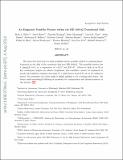Files in this item
An enigmatic pointlike feature within the HD 169142 transitional disk
Item metadata
| dc.contributor.author | Biller, Beth A. | |
| dc.contributor.author | Males, Jared | |
| dc.contributor.author | Rodigas, Timothy | |
| dc.contributor.author | Morzinski, Katie | |
| dc.contributor.author | Close, Laird M. | |
| dc.contributor.author | Juhász, Attila | |
| dc.contributor.author | Follette, Katherine B. | |
| dc.contributor.author | Lacour, Sylvestre | |
| dc.contributor.author | Benisty, Myriam | |
| dc.contributor.author | Sicilia-Aguilar, Aurora | |
| dc.contributor.author | Hinz, Philip M. | |
| dc.contributor.author | Weinberger, Alycia | |
| dc.contributor.author | Henning, Thomas | |
| dc.contributor.author | Pott, Jörg-Uwe | |
| dc.contributor.author | Bonnefoy, Mickaël | |
| dc.contributor.author | Köhler, Rainer | |
| dc.date.accessioned | 2014-09-15T08:31:01Z | |
| dc.date.available | 2014-09-15T08:31:01Z | |
| dc.date.issued | 2014-08-20 | |
| dc.identifier | 148513887 | |
| dc.identifier | 17008809-4589-40bd-a2fd-d4a020bec45f | |
| dc.identifier | 84906344229 | |
| dc.identifier | 000341306900022 | |
| dc.identifier.citation | Biller , B A , Males , J , Rodigas , T , Morzinski , K , Close , L M , Juhász , A , Follette , K B , Lacour , S , Benisty , M , Sicilia-Aguilar , A , Hinz , P M , Weinberger , A , Henning , T , Pott , J-U , Bonnefoy , M & Köhler , R 2014 , ' An enigmatic pointlike feature within the HD 169142 transitional disk ' , Astrophysical Journal Letters , vol. 792 , no. 1 , L22 . https://doi.org/10.1088/2041-8205/792/1/L22 | en |
| dc.identifier.issn | 2041-8205 | |
| dc.identifier.other | ArXiv: http://arxiv.org/abs/1408.0794v1 | |
| dc.identifier.uri | https://hdl.handle.net/10023/5411 | |
| dc.description | MagAO was constructed with NSF MRI, TSIP, and ATI awards. | en |
| dc.description.abstract | We report the detection of a faint pointlike feature possibly related to ongoing planet-formation in the disk of the transition disk star HD 169142. The pointlike feature has a Delta-mag(L) ∼ 6.4, at a separation of ∼ 0" .11 and PA ∼ 0º. Given its lack of an H or KS counterpart despite its relative brightness, this candidate cannot be explained by purely photospheric emission and must be a disk feature heated by an as yet unknown source. Its extremely red colors make it highly unlikely to be a background object, but future multi-wavelength followup is necessary for confirmation and characterization of this feature. | |
| dc.format.extent | 6 | |
| dc.format.extent | 202851 | |
| dc.language.iso | eng | |
| dc.relation.ispartof | Astrophysical Journal Letters | en |
| dc.subject | astro-ph.EP | en |
| dc.subject | astro-ph.SR | en |
| dc.subject | Planets and satellites: detection | en |
| dc.subject | Planets and satellites: formation | en |
| dc.subject | Planets and satellites: gaseous planets | en |
| dc.subject | Protoplanetary disks | en |
| dc.subject | QB Astronomy | en |
| dc.subject | QC Physics | en |
| dc.subject.lcc | QB | en |
| dc.subject.lcc | QC | en |
| dc.title | An enigmatic pointlike feature within the HD 169142 transitional disk | en |
| dc.type | Journal article | en |
| dc.contributor.institution | University of St Andrews. School of Physics and Astronomy | en |
| dc.identifier.doi | 10.1088/2041-8205/792/1/L22 | |
| dc.description.status | Peer reviewed | en |
| dc.identifier.url | http://iopscience.iop.org/2041-8205/792/1/L22/article | en |
This item appears in the following Collection(s)
Items in the St Andrews Research Repository are protected by copyright, with all rights reserved, unless otherwise indicated.

